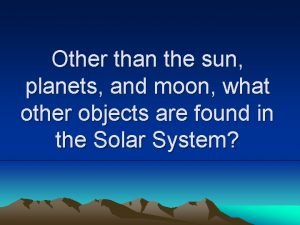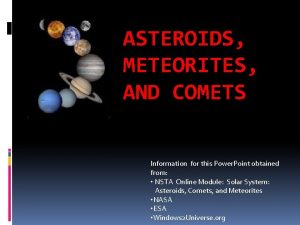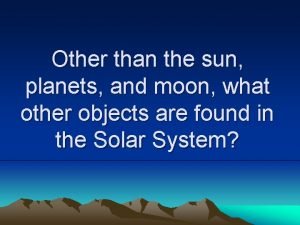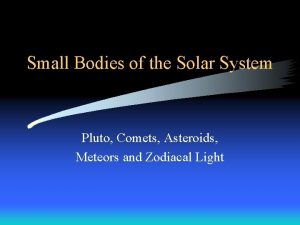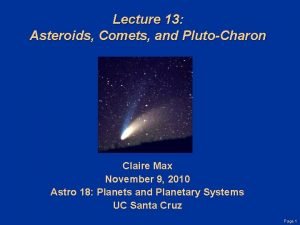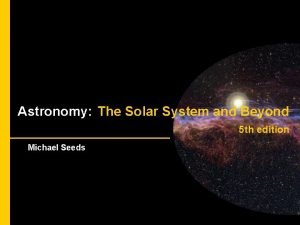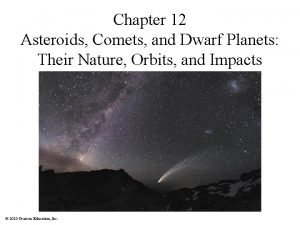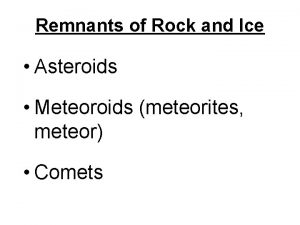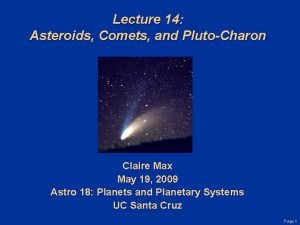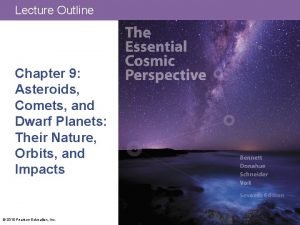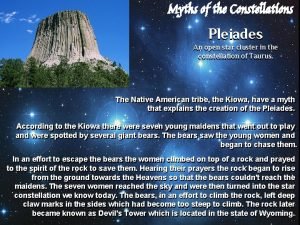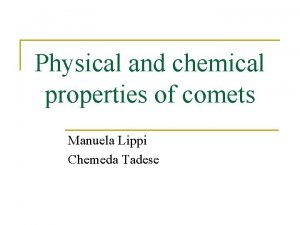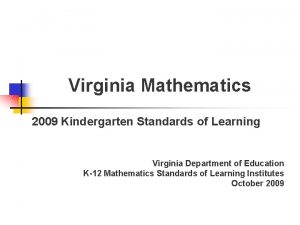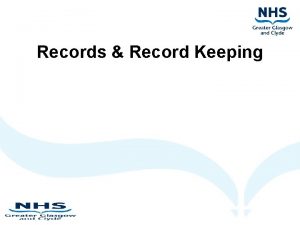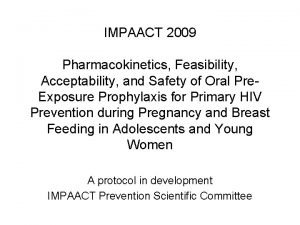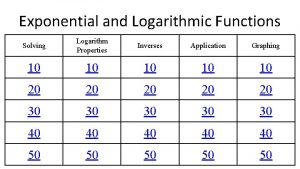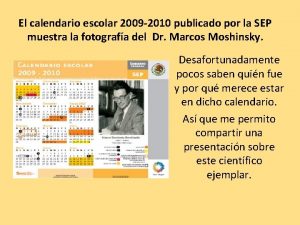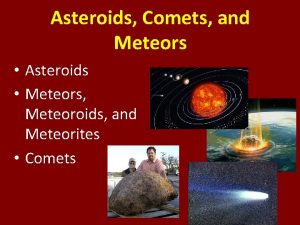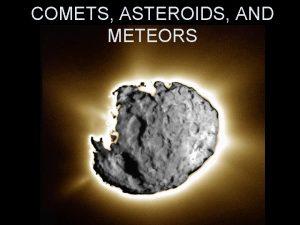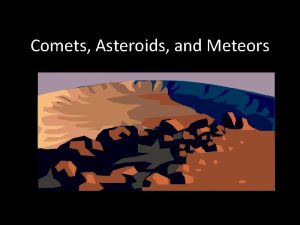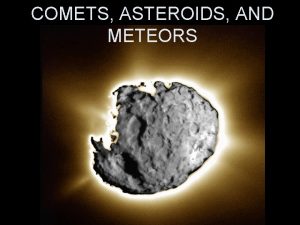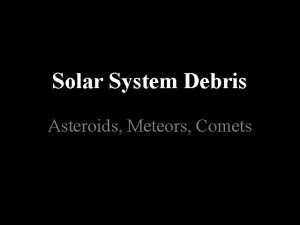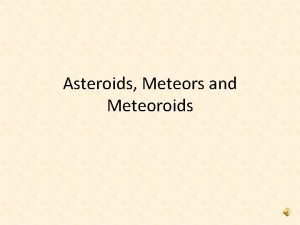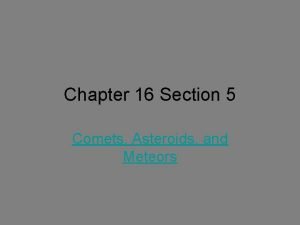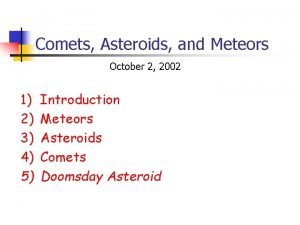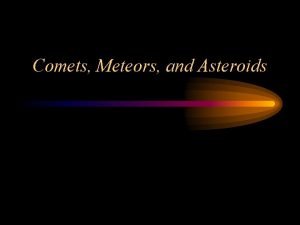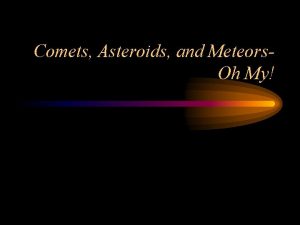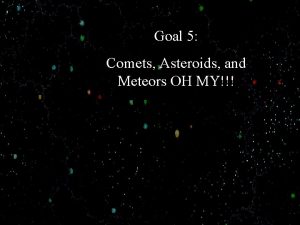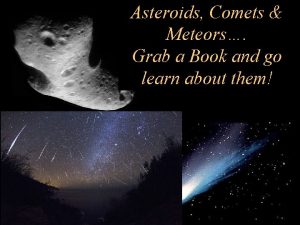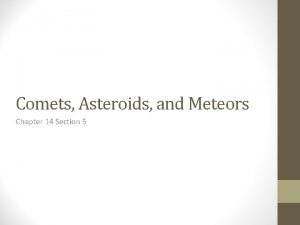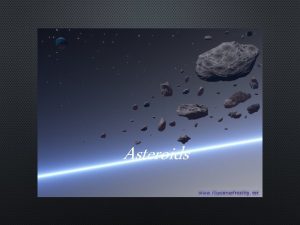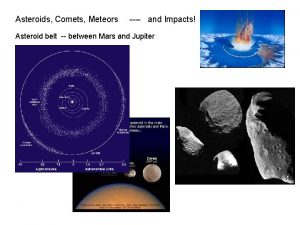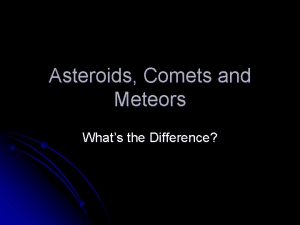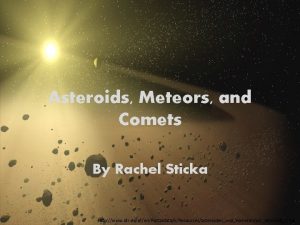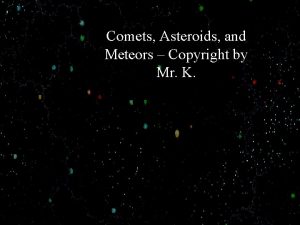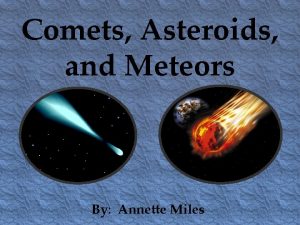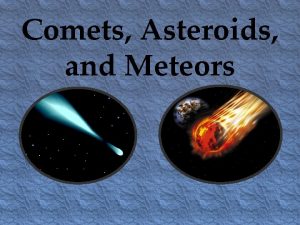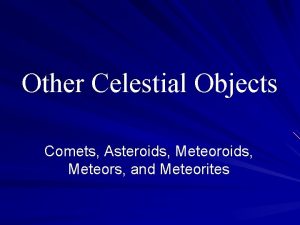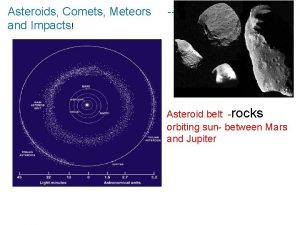Comets Asteroids and Meteors 2009 Comets n n
































- Slides: 32

Comets, Asteroids, and Meteors 2009

Comets n n n Comets are chunks of ice, frozen gases, and dust whose orbits are very long, narrow ellipses. Often thought of as dirty snowballs. Usually can’t be seen, as they leave a bright tail of dust and gas only when near the sun. The heat from the sun sublimates the frozen gases when the comet is near the sun.

Comet Composition n n It is made up of a nucleus (solid, frozen ice, gas and dust). A gaseous coma (water vapor, CO 2, and other gases) only when the comet is near the sun. A long tail (made of dust and ionized gases). The tail develops only when the comet is near the Sun. Believed to be material left over from the formation of the Solar System. It is the most pristine material left from over 4. 5 bya. Comet Tempel 1 Deep Impact Mission

Comet Tempel 1

Comet Structure n n n Nucleus: main solid core of the comet. Tail: gas and dust particles released by the comet. They are pushed by the solar wind away from the sun. Always faces away from the Sun. Coma: gases and dust released by the comet when energy from the sun heats the comet and causes the solid materials to turn into a gas.

Comet Orbits n Most comets are on very eccentric orbits that seldom pass near the Earth.

Comet Clouds n n n Most comets are from one of two clusters, the Kuiper Belt and the Oort Cloud. The Kuipier Belt is close to Pluto, from 30 to 50 AU from the sun. The Oort Cloud is material left over from the formation of the solar system and is about 50, 000 AU (1 light year) from the sun.


Short Period Comets n n Comets that have an orbital period under 200 years. Most originate in the Kuiper Belt. Comet Halley is a famous, short period comet. It appears every 76 or so years. Will apperar next in 2061. Nucleus of Halley’s comet taken by the Giotto spacecraft.

Halley’s Comet n n n Last appeared in 1985 -86. Should appear again in 2061. Like most comets it has a very eccentric orbit. Has been seen every 76 years for over 2000 years.

Long Period Comets n n n Orbital periods of 200 years to possibly over 300 million years. Believed to originate in the Oort Cloud. Possibly be the cause of some mass extinctions on Earth.

Comet Mc Naught n n n Great Comet of 2007 Most visible comet in over 40 years. Visible in the Southern Hemisphere in Jan/Feb 2007.

Asteroids n n n Asteroids are rocky or metallic objects, most, but not all orbit the Sun in the asteroid belt between Mars and Jupiter. A few asteroids approach the Sun more closely. None of the asteroids have atmospheres. Asteroids are also known as planetoids or minor planets. Made of rock and metals. May have water in their interiors.

Mining Asteroids n n n Two companies are making plans for mining valuable metals from asteroids. Metals like gold, iron, platinum, copper, zinc, lead, and many others are likely to be abundant in asteroids. Others plan on hollowing them out and creating space stations from them.

Asteroid Belt n n n The asteroid belt is a doughnutshaped concentration of asteroids orbiting the Sun between the orbits of Mars and Jupiter, closer to the orbit of Mars. Most asteroids orbit from between 186 million to 370 million miles (300 million to 600 million km or 2 to 4 AU) from the Sun. The asteroids in the asteroid belt have a slightly elliptical orbit. The time for one revolution around the Sun varies from about three to six Earth years.

Number of Asteroids n n n There about 40, 000 known asteroids that are over 0. 6 miles (about 1 km) in diameter in the asteroid belt. About 3, 000 asteroids have been cataloged. There are many more smaller asteroids. The first one discovered (and the biggest) is named Ceres; it was discovered in 1801. Ceres

Dawn Mission n Dawn is a robotic NASA spacecraft tasked with the exploration and study of Vesta and Ceres, the two largest members of the asteroid belt. Launched on September 27, 2007, the probe entered orbit around Vesta on July 16, 2011. After a year’s stay, headed for Ceres, where it will arrive in 2015.

Vesta n n n 2 nd largest asteroid In asteroid belt, very reflective, can be seen without a telescope. Some evidence of frozen water below the surface.

Ceres: as seen from Dawn April 2015

Asteroid Size n n n Asteroids range in size from tiny pebbles to about 578 miles (930 kilometers) in diameter (Ceres). Sixteen of the 3, 000 known asteroids are over 150 miles (240 km) in diameter. Some asteroids even have orbiting moons.


Origin of the Asteroid Belt n n n The asteroid belt may be material that never coalesced into a planet, perhaps because its mass was too small. The total mass of all the asteroids is only a small fraction of that of our Moon (about 1/30 th). A less satisfactory explanation of the origin of the asteroid belt is that it may have once been a planet that was fragmented by a collision with a huge comet.

Near-Earth Asteroids n n Asteroids whose orbits bring them within 1. 3 AU of the Sun are called Near-Earth Asteroids (NEA) or Earth-Approaching asteroids. These asteroids probably came from the main asteroid belt, but were jolted from the belt by collisions or by interactions with other objects' gravitational fields (primarily Jupiter).

NEA Concerns n n n About 250 NEAs have been found so far, but many, many more exist. The largest known NEA is 1036 Ganymede, with a diameter of 25. 5 miles (41 kilometers). According to astronomers there at least 1, 000 NEA's whose diameter is greater than 0. 6 miles (1 kilometer) and which could do catastrophic damage to the Earth. Even smaller NEA's could cause substantial destruction if they were to collide with the Earth. http: //www. space. com/19830 neos-near-earth-objects-thevideo-show. html

Demise of the Dinosaurs? n n An asteroid impact with the Earth may have caused the extinction of the dinosaurs. The Alvarez Asteroid Theory explains the huge K-T mass extinction 65 million years ago by a large asteroid hitting the Earth off the Mexican Yucatan peninsula. This impact would have caused severe climactic changes leading to the demise of many groups of organisms, including non-avian dinosaurs. The 6 mile diameter asteroid made a crater 110 miles across!

Meteoroids n n Meteoroids are small chunks of metal and rock in space. Usually come from comets or asteroids. Asteroids = big Meteoroids = small

Meteors n n n When a meteoroid enters the Earth’s atmosphere friction will cause it to heat up. It will leave a bright streak of light across the sky as it burns up. Are called meteors when they brightly fall to the Earth. Also called shooting stars. Often occur in showers, with several sightings a minute.

Meteorites n n While the vast majority of meteors burn completely up, ones that are large enough pass through the atmosphere and hit the surface. Most look like stones, so they are noticed. Some are easy to identify as they are made of iron or nickel.

Craters n n n Meteorites create impact craters when they strike the surface of a planet. Our moon is covered with craters caused by meteorites, asteroids, and comets. Meteor Crater in Arizona is a famous crater found in the USA. Occurred 50, 000 years ago. Hit with the force of 150 Hiroshima A bombs. Was a 150 ft across. It made a crater 3/4 ths of a mile across, and 570 feet deep. Most on Earth have been eroded away.

Impact Craters on earth Two circular lakes/impact craters on the Canadian Shield in Quebec formed simultaneously by the impact of an asteroid pair which crashed on Earth approximately 290 million years ago, near the eastern shore of Hudson Bay.

Deep Bay, Canada Situated near the southwestern tip of Reindeer Lake in Saskatchewan, Canada, Deep Bay is a strikingly circular, very deep and unusually irregular and shallow lake. The 8 mile (13 km) wide crater is a complex impact structure with a low, totally submerged central uplift, formed about 100 million years ago (some say 140 million) when a large meteorite crashed in the area.

Chesapeake Bay Crater n Buried under seafloor muds, Chesapeake Bay Crater offshore of Virginia is an estimated 35 million years old. The curving western shoreline of Chesapeake Bay takes its shape from the 53 -mile-wide (85 km) marine crater.
 What is the difference between meteors and comets
What is the difference between meteors and comets Difference between comets and asteroids and meteors
Difference between comets and asteroids and meteors Asteroids meteors and comets worksheet
Asteroids meteors and comets worksheet Comets asteroids
Comets asteroids An icy leftover planetesimal orbiting the sun is
An icy leftover planetesimal orbiting the sun is Origin of meteorites
Origin of meteorites Origin of asteroids
Origin of asteroids Asteroids
Asteroids A rocky leftover planetesimal orbiting the sun is
A rocky leftover planetesimal orbiting the sun is Jupiter nudges the asteroids through the influence of
Jupiter nudges the asteroids through the influence of Comets diagram
Comets diagram Physical properties of comets
Physical properties of comets Wonnacott discrepancy matrix
Wonnacott discrepancy matrix Coroners and justice act
Coroners and justice act Saunders lewis and thornhill 2009
Saunders lewis and thornhill 2009 Saunders lewis and thornhill 2009
Saunders lewis and thornhill 2009 2008-2009 school year
2008-2009 school year 2009 mathematics standards of learning answers
2009 mathematics standards of learning answers Servicio social uabc 2009
Servicio social uabc 2009 Uma máquina fotográfica custava r$ 400
Uma máquina fotográfica custava r$ 400 Nmc record keeping
Nmc record keeping Cmo 27-2009
Cmo 27-2009 Plan nacional del buen vivir 2009 al 2013
Plan nacional del buen vivir 2009 al 2013 Permenkes no 51 tahun 2009
Permenkes no 51 tahun 2009 R.t.t. 2009
R.t.t. 2009 January 2016 chemistry regents answers
January 2016 chemistry regents answers Institutional calendar
Institutional calendar Rcfce act
Rcfce act Impaact 2009
Impaact 2009 In 2009 there were 1570 bears
In 2009 there were 1570 bears Rosa catania 2009
Rosa catania 2009 Ciclo escolar 2009-2010
Ciclo escolar 2009-2010 Nice 2009
Nice 2009
